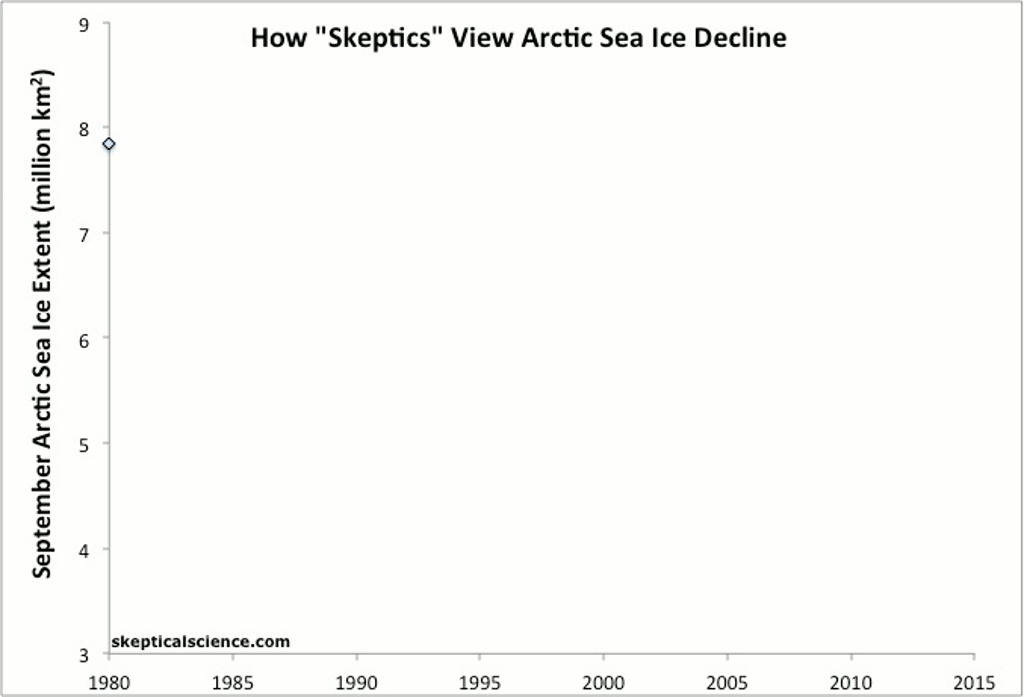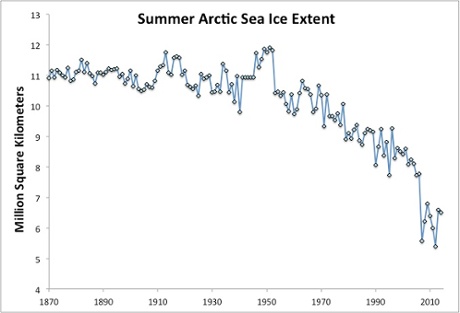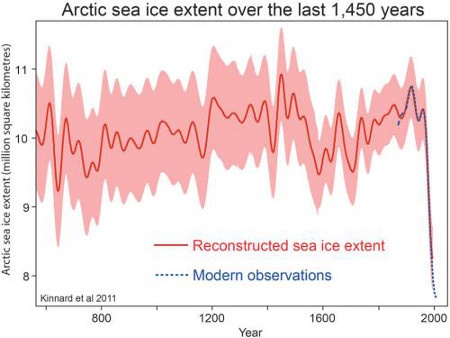
The National Snow and Ice Data Center has reported that this year we saw the 6th-lowest minimum Arctic sea ice extent on record. Research has shown that most of the long-term decline in sea ice, or the “death spiral” as it’s come to be known, is due to human-caused global warming.
Natural factors play a role in the extent of the Arctic sea ice as well, especially changes in weather conditions on a year-to-year basis. For example, 2012 shattered the previous record low Arctic sea ice extent because on top of the human influences, the weather conditions were ripe for a dramatic decline that year. In 2013 and 2014, weather conditions were closer to normal, so they didn’t break the 2012 record. As a result, the usual suspects have declared that Arctic sea ice is now “expanded” compared to 2 years ago.
The flaw in that argument is illustrated in this animated graphic I created.
September Arctic sea ice extent data since 1980 from the National Snow and Ice Data Center (blue diamonds). "Recovery" years, meaning years when the sea ice extent is greater than the previous year, are highlighted in red to mock the repeated cynical claims of climate change "skeptics" that global warming has somehow stopped.
We can also consider Arctic sea ice extent further back in time, over the past 145 years:
 Average July through September Arctic sea ice extent 1870–2008 from the University of Illinois (Walsh & Chapman 2001 updated to 2008) and observational data from NSIDC for 2009–2014.
Average July through September Arctic sea ice extent 1870–2008 from the University of Illinois (Walsh & Chapman 2001 updated to 2008) and observational data from NSIDC for 2009–2014.
Or even the past 1,450 years:
 Reconstructed Arctic sea ice extent over the past 1,450 years, from Kinnard et al. (2011)
Reconstructed Arctic sea ice extent over the past 1,450 years, from Kinnard et al. (2011)
The current Arctic sea ice death spiral is clearly outside the norm and natural variability we’ve seen in recent history.
Exactly how rapidly it will continue to decline is a subject of open debate among climate scientists. A few, like Peter Wadhams and Wieslaw Maslowski had predicted that the Arctic could be nearly ice-free in the summer as early as this year. A few others fall on the opposite extreme, believing like Judith Curry that the death spiral has “reversed.”
The vast majority of climate scientists fall in the middle, with the evidence indicating that the long-term decline will continue as human carbon pollution continues to warm the planet, and the Arctic will eventually become ice free within the next few decades.
There was recently a contentious dispute at a Royal Society Arctic Sea Ice meeting, in which Wadhams felt that his views were being disrespected by some of those mainstream climate scientists. Those scientists argued that Wadhams was misinterpreting their comments, but this dispute illustrates where the climate debate really lies.
Normally the ‘debate’ is depicted as being between climate ‘sceptics’ on one side and mainstream climate scientists on the other. Many bystanders assume that the truth must lie somewhere in the middle. However, in reality it’s the mainstream scientists who fall into the middle of the spectrum, with climate contrarians on one extreme, and those who believe climate scientists are underestimating the impacts of global warming on the other extreme.
Moreover, climate contrarians have made the most consistently inaccurate annual Arctic sea ice predictions to date. Once again this year, contrarian blog readers submitted the most optimistic Arctic sea ice prediction to the competition hosted by the Study of Environmental Arctic Change (SEARCH), and once again their predictions were among the least accurate.
Posted by dana1981 on Thursday, 23 October, 2014
 |
The Skeptical Science website by Skeptical Science is licensed under a Creative Commons Attribution 3.0 Unported License. |